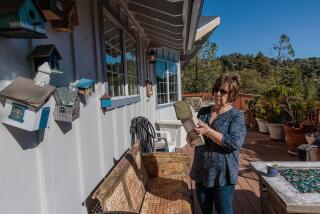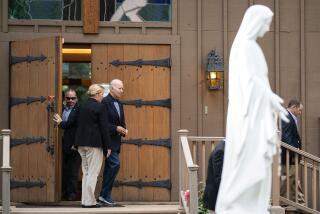Think c-c-c-cold
- Share via
MAYBE it was that ski trip in the local mountains last year. Pristine powder in the morning, blissful skiing all day, followed by fireside chats in the evening. Or maybe you re-read Thoreau and decided it was time to live in the woods for a while.
Whatever form your call of the wild takes, anyone shopping for a winter getaway should be aware of the hassle factors and practical considerations of buying, owning and renting out their refuge, say real estate experts and longtime owners.
Potential buyers ought to consider several aspects of a mountain home’s location and construction before buying, said Mike Riley, Realtor associate at Coldwell Banker Sky Ridge Realty in Lake Arrowhead.
All mountain and lake areas have their own mini-climates, Riley said. Buyers looking for their own private Idaho in a picturesque woodsy setting should know that dense forest areas and shadowy sides of a mountain range will collect and retain more snow than houses in clearings or in sunnier areas, Riley said. “If you buy a place in the trees, you have to understand you may still have a lot of snow in April.”
The direction a house faces can be important. “With a north-facing house, the snow will take longer to melt than with a south-facing house,” Riley said.
Proximity to activities and towns also matters, said Mike Willett, a real estate broker in Tahoe City.
“Skiers might find a house they love that’s 15 miles from the mountain, but during Christmas and New Year’s, there’s traffic, and it could take an hour to get to the hill,” Willett said.
The view can make a big difference. View houses and houses close to skiing command more money from renters.
Sandi Migliazza, who owns a house in Lake Arrowhead, said that being able to see the lake from her house made her want to buy it. “It reminded me of the house my family built on Lake Tahoe many years ago.”
In Lake Arrowhead, a three- to four-bedroom house with a view can fetch at least $100 more per weekend in rent than a comparable house without a view.
But Willett said that buyers need to be wary of “view houses” that are at the top of steep, winding roads because they can be treacherous during snowstorms. Houses that have steep driveways or long staircases up to the front door can pose the same problem.
“Some communities are built on hillsides to take advantage of the view,” he said, “but in the winter, it can be really hard to get up there.”
Buyers also need to be sure the house has a reliable source of heat and good insulation, said Mark McClean, owner of McClean Team GMAC in Mammoth Lakes. “It may not have been used as a winter home before, so it may only have a wood-burning stove or baseboard electric heating.”
And roofs should be thoroughly inspected to make sure that they are designed to shed the snow quickly.
Good roofs for winter climes are peaked or made of metal to allow the snow to slide off.
The cost to maintain a house in a harsh climate, including snow removal, heating and general upkeep, can be considerable. But snow-removal regulations vary widely, so before buying, it’s wise to find out how much removal the town provides and how much homeowners are expected to do on their own, Riley said.
In Lake Arrowhead, Riley said, the county roads are plowed, but the county doesn’t plow access roads -- those narrow homeowner-built roads that are paved but not county-maintained. Homeowners on access roads in Arrowhead have to compete for private plowing services after heavy snowfalls. Plowing can cost up to $600 per snowfall, depending on the road and the snow’s depth.
But even if the town provides the plowing, most homeowners with driveways need to contract with local services to make sure they can get out of their garage after a big storm. Local contractors in Mammoth Lakes charge by the season, and fees run from about $250 to $300. Since Lake Arrowhead gets less snow, plows charge by the hour and can cost $125 per hour.
Betsy Thumann, a Mammoth Lakes homeowner, warns that the use of snowplows on driveways can take a toll on houses.
“I try to tell them not to come so close, but they run into my garage door and the railings on the side of the driveway every time,” Thumann said.
Homeowners also need to know where the water shut-off valves are placed and must be vigilant about turning off the water and draining the pipes if they plan to shut off the heat while they’re gone, Riley said. He learned firsthand a few years ago what can happen if the temperature drops quickly and the water in the pipes freezes.
“The whole irrigation system froze and the pipes burst and flooded my driveway,” Riley said.
He spent $130 having the lines repaired and another $75 to have the water properly shut off.
Local caretakers can be hired to turn off the water and check the house while the owner is gone. Costs start at about $50 a month but can vary widely depending on the extent of services.
Owners who rent out homes through management companies may have those services provided for them, but a company typically takes a 20% to 40% commission on the rental.
Mountain and lake homes generally require more upkeep than homes in areas where the weather is less severe. Prolonged snowy periods and windy climates cause paint to peel and wood to crack more readily.
Migliazza said that she and her husband paint the decks every year, a project that would cost at least $400 per deck if they hired someone. She also had to replace two 10-year-old decks and a staircase last year at a cost of $12,000.
Snow piling up on decks can also cause low-quality doors to rot, as Thumann found out. She replaced the French doors on her four decks after 11 years and now hires workers to shovel the decks at $25 per person per hour.
jenlisle1119@aol.com
More to Read
Inside the business of entertainment
The Wide Shot brings you news, analysis and insights on everything from streaming wars to production — and what it all means for the future.
You may occasionally receive promotional content from the Los Angeles Times.










